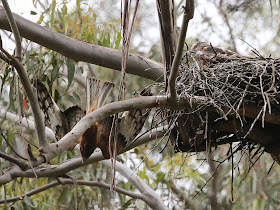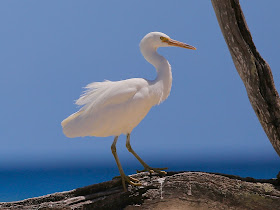Over the
years I have been treated to all too brief sporadic and tantalizing views of lone
Square-tailed Kites at home and further afield in East Gippsland. Last year I learnt
of a pair nesting in forest not too far from home. Apparently, this pair had successfully
reared young at the nest the year before. While they may be rare and possibly sedentary,
or partly migratory, it seems they are faithful to an area and nest, returning
to the same site each breeding season.
I visited
the site last year over a long period when the female sat tight on the nest
incubating eggs with the male nearby at times, but no young appeared. Eventually
they departed the area having failed to raise any young. Most likely the eggs
were infertile.
Fortunately,
the pair were back again early in the breeding season this year, which runs
from August to December, and since late November they have had two rapidly growing
young on the nest.
The nest
area is in dry open eucalypt forest on the foothills of the Dividing Range with
the forest edge and open farmland not far away. The substantial nest of large
sticks is typical, as is its location about 15 metres high in a gum tree
(either a Blue Gum or Grey Gum?). Fortunately, photos are possible from the
ground however the distance is at least twice as long as I would ideally like
for really clear and detailed photos.
Please click on photos to enlarge.
 |
| The male perched in the nest tree above the nest. Note the slight crest and distinctive white face and forehead. |
Square-tailed
Kites (Lophoictinia isura) are perhaps
one of Australia’s rarer and more unusual endemic raptors. DNA/taxonomy places
them in the penine kites group of raptors which in Australia also includes the
Black-breasted Buzzard (Hamirostra
melanosternon) and the Pacific Baza (Aviceda
subcristata).
Most
raptors have a bony protective shield above the eye which gives them a fierce
look but the penines lack this shield.
The genus name
Lophoictinia is from Greek meaning “crested
kite”. They do have a short occipital (back of the head) crest which is not
usually obvious in the field.
 |
| The female briefly left the nest and joined the male for a short flight together above the forest canopy. I was lucky to capture this photo through an opening in the forest canopy. |
 |
| The camera lens is pointing at the nest high in a Blue (Grey?) Gum. |
 |
| The nest with the female’s back just visible. |
 |
| The female Square-tailed Kite briefly off the nest which is just out of the frame above her. |
 |
| The male showing the very long wings which extend well beyond the tail tip and cross over when held closed – this can at times give the impression of a V-tail. |
Once it
became clear the pair were back again this season and the female was sitting
tight on the nest incubating eggs (incubation is mainly by the female), I left
them to it for the incubation period which is about 40 days. Once hatched the
white downy young take about 3 weeks to fledge into a full set of new feathers.
The young fly after about 9 weeks in the nest and the female remains with them almost
until they fly. This means the male is the sole provider for both the female
and the young – a big job especially as the young grow and the quantity of food
they require increases.
Square-tailed
kites have evolved to specialise in hunting in open forest where they primarily
prey on nestlings during the breeding season. This seems unusual for a bird
with such long wings which would perhaps make manoeuvring within a forest
canopy difficult. Their long broad wings enable them to fly with very little
wing beating and they are often seen gliding effortlessly above and through the
forest canopy as they search for prey and nests.
I watched
the nest for an hour or so each time I visited and the male was away hunting most
of the time. The female and young wait for food to be delivered, standing,
sitting, preening, defecating over the edge of the nest. Then some wing
flapping for the young ones now and again, small actions punctuating long
periods of inaction and often for the female, looking up and scanning the sky
for the male.
 |
| It was not often at this stage of development that all three birds were visible at once on the nest. |
 |
| The younger nestling is perhaps a week behind its older sibling but it too is rapidly growing feathers and flaps its wings from time to time. |
And then suddenly
the male swoops in. The female and young ones seemed to be aware when he is on
his way in, their keen eyesight or hearing has alerted them, and even though I
have not seen the male I know something is up when they suddenly become excited.
He lands on the edge of the nest, passes a small food item to the female and is
gone again within seconds. There is hardly any time to capture the action with
the camera. Most visits by the male with food are like this.
 |
| The male drops in suddenly with food. The youngest nestling is just visible under his right wing. He passes the food item to the female who is obscured by his wings. |
 |
| In seconds the male plummets head first down and away from the nest – off to find more food. |
 |
| The female ripped the small food item in two and fed both pieces to the younger nestling – the food was gulped down in seconds. |
She then
called for a minute of so – I felt she was urging the male to bring more food –
however if he was nearby and within hearing range I could not see him. The
sudden burst of action is soon over and all three birds settle down to wait
again for the next food delivery.
 |
| The wait for the next food delivery begins again. |
Another
food delivery about 45 minutes later and this time I manage to capture a photo
clearly showing the food item, a very small nestling, possibly taken from a
honeyeater’s nest, as they are often targeted by Square-tailed Kites. Sometimes
the male will apparently bring a nest in complete with the young nestlings
inside but I have not yet seen this.
 |
| Small nestlings like this are probably a large component of what the male is bringing in at this stage. |
This would
explain the rapid consumption of food items by the young with minimal preparation
by the female parent at the nest. The prey item in the above photo was fed to
the younger bird which after a little effort, managed to swallow the small
nestling whole. The older nestling was fed the previous food delivery. From the
limited observations I have made she seemed to be ensuring the younger nestling
got its share of the incoming food.
 |
| Another photo capturing the male departing after a food drop off. |
 |
| From time to time she moved off the nest to a branch just below the nest where she would stretch and preen. The very long primary flight feathers show well in this photo. |
Hopefully
this pair of Square-tailed Kites will successfully raise the two young ones and
I can get back to the site and capture some photos of them before they fly.












































